Global Warming Effect
Ice Under Fire: Antarctica
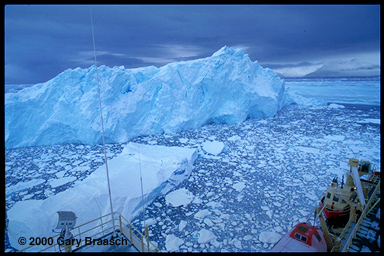
The disintegrating face of the Müller Ice Shelf, Lallemand Fjord, Antarctic Peninsula, 67° South, April 2, 1999. This small shelf, fed by glaciers from the Loubet Coast, has been receding recently after growing over a 400-year cooling period. Like other receding ice shelves such as the larger Larsen, it may be a sensitive monitor of rising regional temperatures. The Larsen Ice Shelf lost a 1200 square mile section early in 2002. Earlier in the 1990's other huge sections of this shelf disintegrated. In 2003 Argentine glaciologists reported that the land-based glaciers exposed by the removal of those sections had surged rapidly into the ocean. Thus, although ice shelves are floating and do not add to sea level when they melt or break up, land based glaciers released by such events definitely will add to sea level.
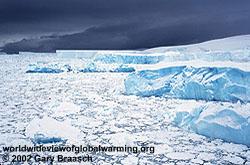
 Another view of the Müller Ice Shelf calving rapidly (right). Across the Peninsula, seven monitored ice shelves have declined by a total of about 13,500 km2 since 1974, according to the National Snow and Ice Data Center. This is nearly the area of Connectcut. On the Larsen shelf (satellite view left), about 3,250 km2 of shelf in area B disintegrated in a 35-day period beginning on 31 January 2002. Eugene Domack, Hamilton College geologist, and others believe this portion of the shelf may have been stable for about 12,000 years before this year's collapse.
Another view of the Müller Ice Shelf calving rapidly (right). Across the Peninsula, seven monitored ice shelves have declined by a total of about 13,500 km2 since 1974, according to the National Snow and Ice Data Center. This is nearly the area of Connectcut. On the Larsen shelf (satellite view left), about 3,250 km2 of shelf in area B disintegrated in a 35-day period beginning on 31 January 2002. Eugene Domack, Hamilton College geologist, and others believe this portion of the shelf may have been stable for about 12,000 years before this year's collapse.
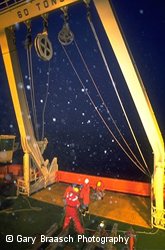 Technicians for the National Science Foundation on the rear deck of the research vessel, Nathaniel B. Palmer, prepare a kasten core device to lower into sediment near the Müller Ice Shelf. This is during a study by Dr. Eugene Domack, funded by the National Science Foundation, on the history of climate in peninsular Antarctica. All ice shelves in the area have been receding, but because they were already floating they do not raise sea level. The concern is that landed glaciers behind the shelves may be next to begin rapid retreat, which would raise ocean levels.
Technicians for the National Science Foundation on the rear deck of the research vessel, Nathaniel B. Palmer, prepare a kasten core device to lower into sediment near the Müller Ice Shelf. This is during a study by Dr. Eugene Domack, funded by the National Science Foundation, on the history of climate in peninsular Antarctica. All ice shelves in the area have been receding, but because they were already floating they do not raise sea level. The concern is that landed glaciers behind the shelves may be next to begin rapid retreat, which would raise ocean levels.
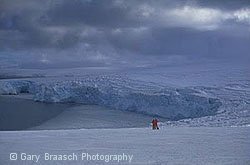 This mile-long ice cliff of Marr Ice Piedmont, Anvers Island, has receded about 500 meters since the mid 1960s. The cliff's previous position was to the left of the line of ice floating in the harbor and extended to the headland at the extreme upper left. The regional temperature has increased 5° C in winter over the past 50 years. This reduces seasonal icepack, disrupts growth of krill and changes conditions on penguin rookeries.
This mile-long ice cliff of Marr Ice Piedmont, Anvers Island, has receded about 500 meters since the mid 1960s. The cliff's previous position was to the left of the line of ice floating in the harbor and extended to the headland at the extreme upper left. The regional temperature has increased 5° C in winter over the past 50 years. This reduces seasonal icepack, disrupts growth of krill and changes conditions on penguin rookeries.
For more on glacier recession and around the world, please see Ice Under Fire, the Mountain Glacier section.
Pushing the Boundaries of Life: Antarctica

A colony of Adelies on Humble Island, one of eight islets off Anvers Island where thousands of Adelies have nested for some 600 years. Over the last 25 years these Adelie colonies have declined sharply. Chinstrap penguins are moving rapidly into Adelie territory. Archaeological digs in penguin colonies indicate there probably were no chinstraps in this area until about 50 years ago, when average temperatures began to rise.
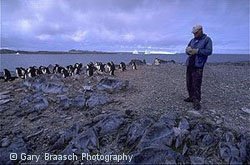
Ornithologist Bill Fraser stands on the smooth pebbly surface of a former large colony of Adelie penguins on Torgersen Island. Unlike the colony in the photo above, this nesting site has been used by fewer and fewer penguins over recent years. Analyzing climate data, island topography, and breeding statistics, Fraser believes climate change caused the loss of half of its 16,000 nesting Adelies. Warming temperatures and more open water make for greater snowfall and more difficult hunting for krill, affecting nesting success. These changes are seen in other Adelie colonies on the Antarctic peninsula, but elsewhere in Antarctica, climate change either is favorable to the birds or is not affecting them.
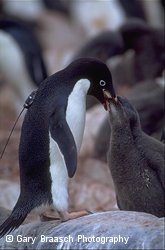 A male Adelie penguin, back from a long feeding trip, disgorges krill for its chick. Krill develop best under seasonal ice, so thinner, less extensive winter ice can reduce the size of the shrimp-like Antarctic staple. The tiny radio transmitter on this bird's back allows Dr. Fraser to monitor how far and for how long penguins hunt for food. For some colonies, hunting times are becoming longer and longer as diminished seasonal sea ice extends the distance from rookery to feeding ground.
A male Adelie penguin, back from a long feeding trip, disgorges krill for its chick. Krill develop best under seasonal ice, so thinner, less extensive winter ice can reduce the size of the shrimp-like Antarctic staple. The tiny radio transmitter on this bird's back allows Dr. Fraser to monitor how far and for how long penguins hunt for food. For some colonies, hunting times are becoming longer and longer as diminished seasonal sea ice extends the distance from rookery to feeding ground.
Although the Adelie penguin is not threatened as a species by global warming or man-caused problem so far, many species of this bird are. In a landmark decision that nevertheless fell short of conservationists' proposals, the US Fish and Wildlife Service proposed seven penguin species as candidates for 'threatened" status under the Endangered Species Act.
Included in the December 2008 document are the African penguin, yellow-eyed penguin, white-flippered penguin, Fiordland crested penguin, Humboldt penguin, and erect-crested penguin and a portion of the range of the southern rockhopper penguin. However, the ruling denied listing for the majority of the range of the southern rockhopper penguin, as well as for the northern rockhopper penguin, macaroni penguin, and emperor penguin.
The emperors, the ones in the film "March of the Penguin" are among species which are losing numbers apparently due to warming seas, reduced summer sea ice, and lack of their prime food, krill. If the candidate species are found by additional study and public comment to be worthy of being listed, they will receive protection under the Endangered Species Act sometime in 2009.http://www.worldviewofglobalwarming.org/pages/antarctica2.html






0 comments:
Post a Comment